Florida’s First Coast – History Lessons Among the Dunes
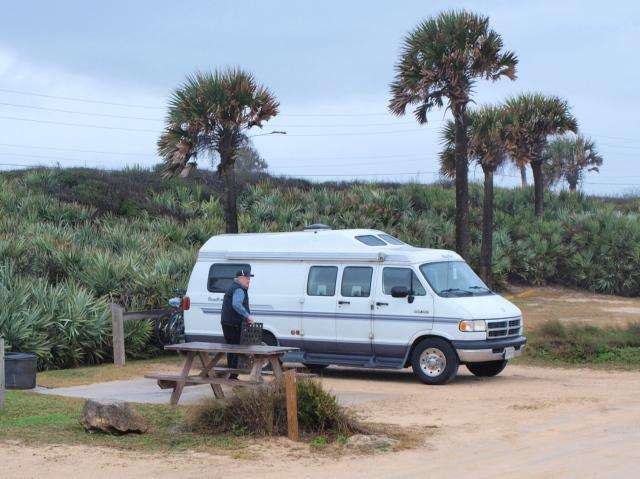
I am camping at Gamble Rogers Memorial State Recreation Area, a treasured reservation for snowbirds fleeing the brutal winter weather up North.
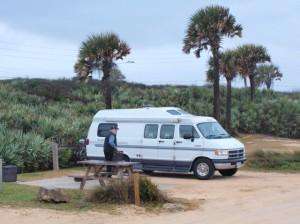
I'm surrounded by Yankees walking around with blissful smiles on their faces in the 60 degree temperatures and sunshine here on Florida's first coast. Because I have lived near here for decades, I've learned the history of the settlement of this area, which includes many odds and ends of global struggles over the centuries.
Right up the coastal highway is Saint Augustine, the oldest continuously inhabited European settlement in the US. Florida started out Spanish, who ran off the French Huguenots also trying to settle the area. It was Inquisition time, and in addition to territorial disputes there were also religious differences between the two groups, settled emphatically in favor of the Spanish at Matanzas Inlet right up the road (matanzas is Spanish for massacre).
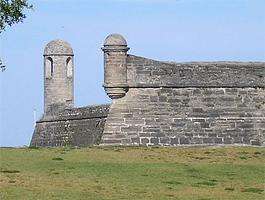
Florida was later British and briefly Spanish again as various treaties divided up the spoils of European wars. Regardless of who was in charge, they and the native Americans liked to make things difficult for the slave-holding Americans to their north by welcoming runaway slaves, who formed the first free black communities in the Americas and assimilated into the native American tribes, who had been forced down into Florida by the settlement of Georgia and Alabama. European diseases so decimated the original Timucuan tribes that the remaining members left with the evacuating Spanish by boat.
In 1819 Florida became part of the United States via treaty with Spain. Many of the free blacks fled to Cuba and the Bahamas, but some stayed with the Seminoles, who fought a remarkably successful military campaign against the US Army, led by Billy Bowlegs, who had the distinction of defeating three future US presidents in battle. Eventually, many of the Seminoles were removed to Oklahoma, but the more fractious stayed and retreated into the Everglades, which the US government, based on their past experience trying to defeat the Seminoles on their home turf, wisely decided would be an excellent place for a reservation, and there they remain – the only native tribe east of the Mississippi still living on lands they successfully defended in battle.
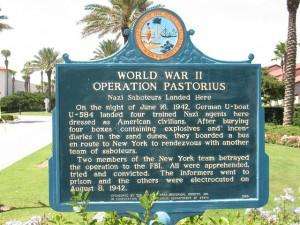
Another interesting historical tidbit is Operation Pastorius – an attempt by Nazi Germany to land saboteurs in the US six months after Pearl harbor. U-boats deposited teams of English-speaking German soldiers on Long Island and also South Ponte Vedra Beach, which was an isolated stretch of nothing back then. Unfortunately for the Germans, prior mistreatment of these soldiers by the Nazis prompted two of them to rat the whole operation out to the FBI, and all except the two informants were executed as spies. There's a historical marker on the spot they landed.
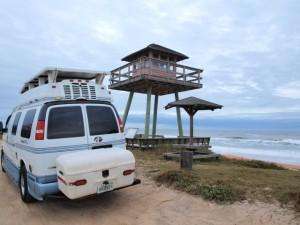
The scare from the discovery of this operation prompted the Army to construct coastal watch stations, and Gamble Rogers where I am staying is the site of one of these stations. It was a different situation back then – German U-boats had turned the Atlantic coast into a shooting gallery for Allied shipping, and my mom remembers blackouts during the war when she lived in Miami. Time and a front row seat on the Hurricane Alley firing lines have destroyed most of the coastal watch towers, but there's one left just south of here (surrounded by condos, of course). Florida was a different place back before all the tourists and development. There's no way anyone could sneak ashore these days 😉

That rv you drive looks like my family built back in the day… xplorer motor homes brown city michigan
Any part of Florida is good!
Great History lesson! Now We want to visit this Winter!
Our favorite St Park in Fl. Very hard to get rsvs any time of yr
Interesting. Carol Sachse, you might like the history. 🙂
Florida has some wonderful state parks. On your way back north stop in Fernandina Beach, a Historic Victorian Seaport town and stay in Fort Clinch State Park which overlooks Cumberland Island National Park.
Very informative! Thank you!
Appreciate hist lesson and looks like nice spot to spend time.
Cool!! Just like mine.
Thank you, that was interesting!!!
So happy to see you enjoying one of my all time favorite campgrounds!!! Love it.
Spending the Long Weekend in Winthrop, Wash. and saw a Roadtrek last night at a fundraiser.
Luv doing it
Interesting article. Nice to know all the history. Thanks
Thank you! Very intersting piece of historic information! Enjoyed reading it!
Try Ft Pickens Fla for that
Feeling NWF
We have a 91…..everything works except speedometer….excellent shape…… Could be for sale…..never use it for health reasons…
I’ve got a 1993 and I love it. Everything works but the frig. See you in Florida some day 🙂
Good one campskunk,really impressed with that 95 dodge roadtrek popular,looked at that model last year,it was a 170,however way too small,but i did like the look of the dodge,it aged well.
those 318 motors last FOREVER. some of the dodges develop transmission problems in their second decade, but overall it’s a 300k mile chassis. just gotta do the maintenance.
I would like to recommend a book called, as best I remember, “The Commodore’s Story.” It is a story about Miami when it was just a village and the mail was delivered by a Sharpie sailboat. Lots of adventures in the mangroves.
Thanks Campskunk….love this historical tidbit. Although our weather is mild here in the Pacific Northwest, we are experiencing lots of rain right now so I am very envious. My son and his friends once drove from Vancouver BC to Florida in 54 hours taking shifts driving. As you can imagine, I was a nervous wreck for them but they arrived safely as the friendly truckers took care of them along the way. I think I need to find out their route but I would do it much slower. I always remember to give the truckers my respect when driving the highways.